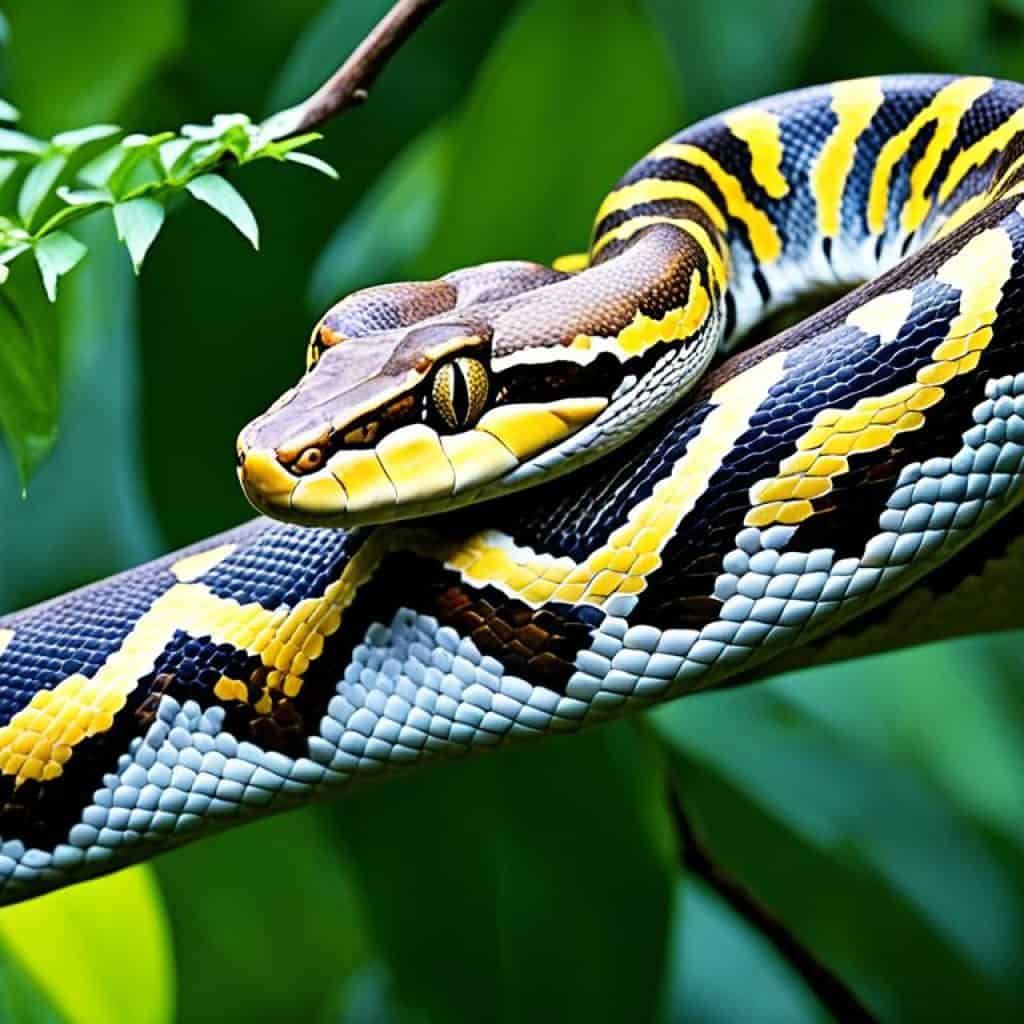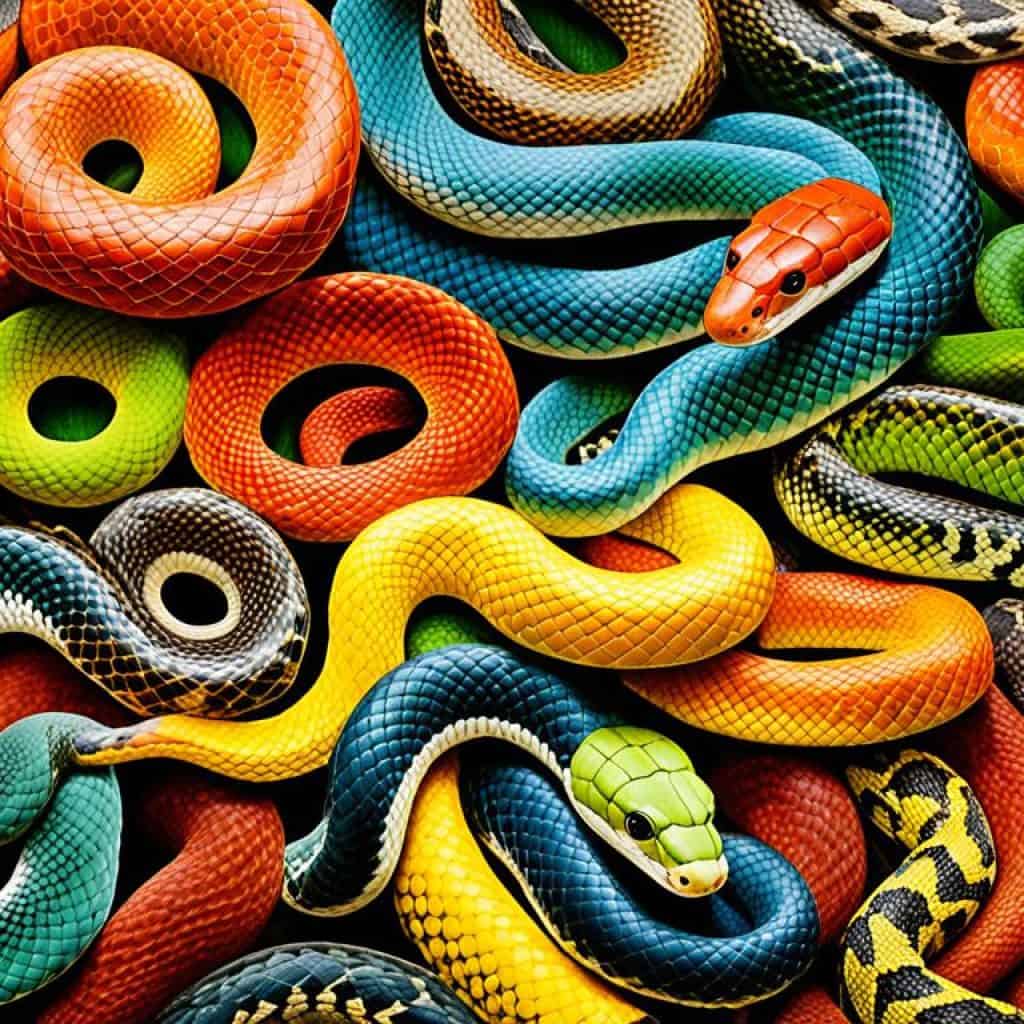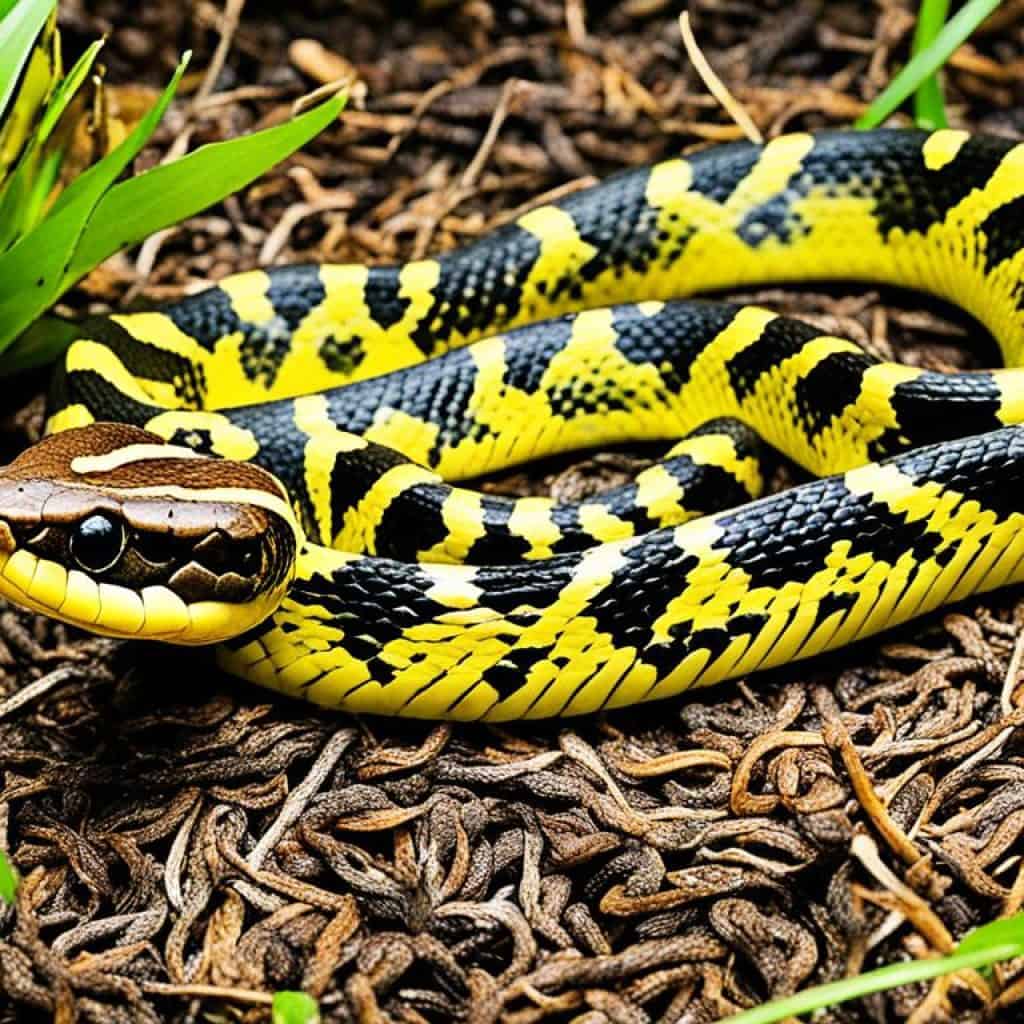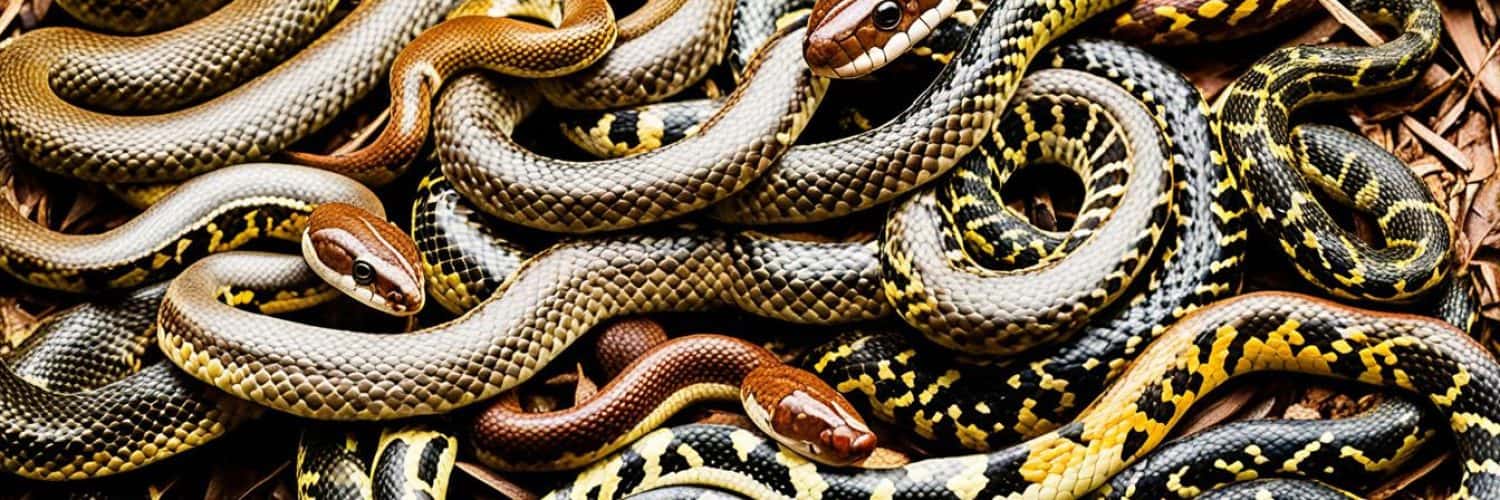Have you ever wondered what types of snakes could be lurking in your own home? The Philippines is known for its diverse snake population, and some of these slithering creatures can commonly be found in houses. Whether you’re a homeowner or simply curious about these fascinating reptiles, join us on a journey to discover the common house snakes in the Philippines.
Key Takeaways
- The Philippines is home to a variety of snake species, including those that can be found in houses.
- Some common house snakes in the Philippines include the Common Mock Viper, King Cobra, Oriental Whipsnake, Reticulated Python, and Brahminy Blindsnake.
- While encounters with house snakes are not uncommon, most of these species are non-venomous and pose little threat to humans.
- House snakes in the Philippines can be found in various habitats, including tropical wet forests and forest edge habitats.
- Snakes are popular pets in the Philippines, but it is important to research and meet their specific care requirements.
Common Mock Viper (Psammodynastes pulverulentus)
The Common Mock Viper, scientifically known as Psammodynastes pulverulentus, is a non-venomous snake commonly found in the Philippines. Despite its name, this snake poses no threat to humans as it lacks venom. With a maximum length of 65 cm, the Common Mock Viper showcases distinctive characteristics that make it easily recognizable.
One notable feature of this snake is its brown coloring, adorned with darker brown and white flecks. This intricate pattern provides effective camouflage, allowing the Common Mock Viper to blend seamlessly into its natural environment. It is often found in tropical wet forests, where it can climb trees and branches with ease.
“The Common Mock Viper is a fascinating snake species known for its unique appearance and harmless nature. Its brown coloration with contrasting flecks makes it a visually interesting snake to observe in the wild.”
Although encounters with the Common Mock Viper may occur, especially in wooded areas, there is typically no cause for concern. This snake primarily feeds on small vertebrates and insects, helping to regulate the local ecosystem by controlling pest populations.
King Cobra (Ophiophagus hannah)
The King Cobra, scientifically known as Ophiophagus hannah, holds the title as the longest venomous snake in the Philippines, capable of reaching lengths of up to 5.4 meters. This majestic serpent is easily distinguished by its olive green color adorned with striking black and white bands along its body. The King Cobra possesses a distinctive feature – a prominent hood and a rounded nose that enhances its regal appearance.
While not inherently aggressive, the King Cobra can display a heightened defensive behavior when it comes to protecting its precious eggs. Its venom is exceptionally potent and considered a serious threat to human health. A bite from a King Cobra can result in excruciating pain, respiratory failure, and a range of severe symptoms.
“The King Cobra’s presence in the Philippine ecosystem is a testament to the unique biodiversity found in the country. As a top predator, it plays a vital role in balancing the ecosystem and maintaining a healthy population of prey species. Despite its fearsome reputation, it deserves our admiration and respect.”
Key Features of the King Cobra:
- Olive green color with black and white bands
- Prominent hood and rounded nose
- Lengths of up to 5.4 meters
- Defensive behavior when protecting eggs
- Powerful venom with severe health implications
| Feature | Description |
|---|---|
| Color | Olive green with black and white bands |
| Length | Up to 5.4 meters |
| Defensive Behavior | Aggressive when protecting its eggs |
| Venom | Highly potent, causing severe symptoms in humans |
Oriental Whipsnake (Ahaetulla prasina)
The Oriental Whipsnake, scientifically known as Ahaetulla prasina, is a stunning snake species found in the Philippines. With its vibrant colors and unique features, it is certainly a captivating creature to behold.
This snake can grow up to 1.8 meters in length and possesses a slender body with a long, pointed snout. Its coloring varies from light brown to dull yellow-green and even fluorescent green, making it stand out in its natural habitat.
The Oriental Whipsnake is primarily found in forest edge habitats, where it can move with ease among trees and branches. This arboreal species is diurnal, meaning it is most active during the day, making it a fascinating sight for nature enthusiasts.
Despite being mildly venomous, the Oriental Whipsnake poses no threat to humans. Its venom is not potent enough to cause severe harm, and it typically uses it to immobilize its prey.
The Oriental Whipsnake is a true testament to the beauty and wonder of nature. Its striking colors and agile nature showcase the incredible adaptations of snakes in the Philippines.
Characteristics of the Oriental Whipsnake:
- Length: Up to 1.8 meters
- Body: Slender with a long, pointed snout
- Coloring: Light brown, dull yellow-green, and fluorescent green
- Habitat: Forest edge habitats
- Activity: Diurnal (active during the day)
- Venom: Mild and non-threatening to humans
Here is a comparison table highlighting the key characteristics of the Oriental Whipsnake:
| Characteristic | Description |
|---|---|
| Length | Up to 1.8 meters |
| Body | Slender with a long, pointed snout |
| Coloring | Light brown, dull yellow-green, and fluorescent green |
| Habitat | Forest edge habitats |
| Activity | Diurnal (active during the day) |
| Venom | Mild and non-threatening to humans |
Reticulated Python (Malayopython reticulatus)
The Reticulated Python, scientifically known as Malayopython reticulatus, is the largest snake species found in the Philippines. Adults of this species can reach astounding lengths of up to 6.5 meters. They possess a strikingly beautiful and intricate pattern on their bodies consisting of varying shades of brown, black, gray, white, and yellow.
This magnificent serpent can be found in a variety of habitats, including woodlands, rainforests, grasslands, and near bodies of water. As an ambush predator, the Reticulated Python relies on its large size and powerful constriction to capture and subdue its prey, which primarily consists of mammals and birds.
While the Reticulated Python typically avoids human contact, rare instances of preying on humans have been recorded. It is essential to remember that such encounters are extraordinarily uncommon and should not overshadow the fact that these pythons play a vital role in balancing ecosystems.
This species is a true testament to the awe and wonder of the natural world, showcasing the magnificence and adaptability of the serpent kingdom.
Key Points about the Reticulated Python:
- The Reticulated Python is the largest snake species in the Philippines, reaching lengths of up to 6.5 meters.
- It has a complex geometric pattern of brown, black, gray, white, and yellow on its body.
- This species is found in woodlands, rainforests, grasslands, and near bodies of water.
- The Reticulated Python is an ambush predator that primarily feeds on mammals and birds.
- While it typically avoids humans, rare instances of preying on humans have been documented.
For a visual glimpse into the mesmerizing beauty of the Reticulated Python, take a look at the image below:

The Reticulated Python is undoubtedly a captivating species that showcases the immense diversity of snakes found in the Philippines. Its remarkable size, intricate patterns, and essential ecological role make it a fascinating creature to study and appreciate.
Brahminy Blindsnake (Indotyphlops braminus)
The Brahminy Blindsnake, scientifically known as Indotyphlops braminus, holds the distinction of being the smallest snake in the Philippines, measuring a mere 5.1 to 10.2 centimeters in length. Its delicate, worm-like body often leads to misidentification as an earthworm. Fortunately, this diminutive creature poses no threat to humans, as it lacks venom and subsists on a diet of ants and termites.
The Brahminy Blindsnake’s underground dwellings in ant and termite nests provide it with the ideal habitat. However, it is not confined solely to wilderness settings. This remarkable species can often be found in suburban and urban gardens, as well as moist forests throughout the Philippines.
Despite its small size, the Brahminy Blindsnake plays a crucial role in the ecosystem. Its presence helps control ant and termite populations, contributing to the balance of various ecosystems where it resides.
In summary, the Brahminy Blindsnake, the Philippine’s tiniest snake species, is harmless and thrives in a variety of environments. Its unique characteristics and ecological significance make it an intriguing species to study and appreciate.
Common House Snakes in the Philippines
In addition to the specific snake species mentioned above, there are several other common house snakes in the Philippines. These include various species of keelbacks, slug snakes, whip snakes, and more. While encounters with house snakes in the Philippines are not uncommon, it’s important to remember that most of these species are non-venomous and pose little to no threat to humans.
Popular House Snakes in the Philippines
Here are some of the popular house snakes in the Philippines:
- Philippine Keelback
- Philippine Slug Snake
- Philippine Whip Snake
Types of House Snakes in the Philippines
There are several types of house snakes that can be found in residences in the Philippines. These snakes have adapted to living in human habitats and can often be found near houses or gardens. Here are some common types:
- Common Mock Viper
- King Cobra
- Oriental Whipsnake
- Reticulated Python
- Brahminy Blindsnake
Encountering a snake in your residence can be alarming, but it’s important to remain calm and remember that most house snakes in the Philippines are harmless. If you come across a snake, it is best to seek professional assistance for its safe removal.

| Snake Species | Size | Venomous |
|---|---|---|
| Common Mock Viper | Up to 65 cm | No |
| King Cobra | Up to 5.4 meters | Yes |
| Oriental Whipsnake | Up to 1.8 meters | Mildly venomous |
| Reticulated Python | Up to 6.5 meters | No |
| Brahminy Blindsnake | 5.1 to 10.2 centimeters | No |
House Snake Habitats in the Philippines
House snakes in the Philippines can be found in a variety of habitats. These snakes have adapted to various environments, allowing them to thrive in both natural and residential areas. Understanding their preferred habitats can help homeowners identify potential snake encounters and take preventive measures.
Some species, such as the Common Mock Viper, are commonly observed in tropical wet forests. These snakes are equipped to navigate the dense vegetation and damp conditions of their natural habitat. Their coloration and behavior allow them to blend in seamlessly with their surroundings, making them difficult to spot.
On the other hand, snakes like the Oriental Whipsnake are often found in forest edge habitats. These snakes prefer areas where the forest meets open spaces, such as grasslands or clearings. By residing in these transitional zones, they have access to both the shelter of the forest and the potential prey found in open areas.
Many house snakes in the Philippines are arboreal, meaning they spend a significant amount of time in trees or branches. This includes species like the Oriental Whipsnake mentioned earlier. Being arboreal allows these snakes to take advantage of the vertical space, hunt for prey, and escape potential predators.
It’s not uncommon to find house snakes in residential areas, especially if there is a nearby food source. These snakes may be attracted to areas with abundant rodents, insects, or small mammals. By understanding the factors that attract snakes to homes, homeowners can implement measures to minimize the likelihood of snake encounters.
Preventive Measures for House Snakes
To reduce the potential for snake encounters in residential areas, homeowners can take the following preventive measures:
- Keep yards and gardens well-maintained, minimizing potential hiding spots for snakes.
- Regularly remove debris, such as piles of leaves or wood, that can serve as a breeding ground or shelter for snakes.
- Seal any cracks or gaps in the foundation, walls, or roof of the house to prevent snakes from entering.
- Keep food sources for snakes, such as bird feeders or pet food, securely stored.
- Trim tree branches and shrubs away from the house to discourage snakes from using them as access points.
- If encountering a snake, do not attempt to handle or remove it yourself. Call a professional snake handler or wildlife control service for safe removal.
By being aware of the habitats that attract house snakes and implementing preventive measures, homeowners can create a safer and more snake-free environment. However, it’s important to remember that most house snakes in the Philippines are non-venomous and pose little to no threat to humans.
| Snake Species | Habitat |
|---|---|
| Common Mock Viper (Psammodynastes pulverulentus) | Tropical wet forests |
| Oriental Whipsnake (Ahaetulla prasina) | Forest edge habitats |
| (Add snake species) | (Add preferred habitat) |
Pet Snakes in the Philippines
Snakes make fascinating and unique pets, and the Philippines is home to a thriving community of snake enthusiasts. Keeping pet snakes is legal in the country, but it’s crucial to conduct thorough research and meet their specific care and housing requirements to ensure their well-being. Here are some popular pet snake species you can consider:
| Pet Snake Species | Description |
|---|---|
| Ball Pythons | A small to medium-sized python species known for their docile nature and beautiful patterns. They are relatively easy to handle and have a long lifespan of up to 30 years. |
| Corn Snakes | A slender and brightly colored snake species known for their gentle temperament. They are highly adaptable and come in various morphs, making them popular among snake enthusiasts. |
| Reticulated Pythons | The largest snake species in the Philippines, known for their impressive size and striking patterns. Reticulated pythons require experienced snake owners due to their size and potential strength. |
When considering a pet snake, it’s essential to ensure you have the necessary knowledge and resources to provide proper care. Snakes have specific dietary needs, temperature requirements, and enclosure setups that must be catered to. Proper handling techniques and regular veterinary check-ups are also crucial to maintain their health and well-being.
Remember: Pet snakes are a long-term commitment, so make sure you’re fully prepared to provide them with the care and attention they need for their entire lifespan.
By following responsible pet ownership practices, you can enjoy the rewards of having a mesmerizing and unique pet snake while contributing to their conservation and promoting a deeper understanding of these fascinating creatures.

Additional Resources:
- Snake Breeders Association of the Philippines
- Philippine Herpetological Society
- Snakes of the Philippines: A Guide to Common Species
Snake Encounters in Philippine Residences
Living in the beautiful Philippines comes with its fair share of nature’s wonders, including encounters with snakes in residential areas. Due to the proximity of houses to natural habitats, it is not uncommon to find these slithery creatures making an accidental appearance in your home. But fear not! With the right approach, you can safely navigate these encounters and ensure the well-being of both yourself and the snake.
Remain Calm and Avoid Sudden Movements
If you spot a snake in your home, it’s essential to remain calm and composed. Sudden movements can startle the snake, potentially leading to defensive behavior. Remember, most house snakes in the Philippines are non-venomous and prefer to avoid confrontation when possible. By staying calm, you minimize the chance of triggering any aggression from the snake.
Seek Professional Assistance
While it may be tempting to take matters into your own hands, it’s best to leave snake handling to the experts. Calling a professional snake handler or wildlife control service ensures the safe removal of the snake from your residence. These professionals have the knowledge and experience to handle snakes safely and humanely, minimizing any harm to both the snake and yourself.
“In encounters with snakes, remember to stay calm and seek professional assistance for safe removal. Your safety and the snake’s well-being are equally important.”
Prevention Measures
Taking preventive steps can help reduce the likelihood of snake encounters in your Philippine residence. Some simple measures you can implement include:
- Sealing cracks and gaps around doors and windows to prevent snake entry.
- Keeping your yard clean and tidy, minimizing potential hiding spots for snakes.
- Trimming bushes and shrubs regularly to remove potential snake habitats.
- Storing firewood, debris, and other materials away from your home to discourage snakes from seeking shelter.
By following these preventive measures, you can create an environment that is less attractive to snakes and reduce the chances of them finding their way into your residence.
A Visual Representation: Snake Encounters in Philippine Residences
To further illustrate the importance of handling snake encounters in Philippine residences, take a look at this visually engaging representation:
| Prevention Measures | Benefits |
|---|---|
| Sealing cracks and gaps | Minimizes snake entry points |
| Maintaining a clean yard | Reduces potential hiding spots |
| Regular bush and shrub trimming | Removes snake habitats |
| Proper storage practices | Discourages snakes from seeking shelter |
Therefore, by implementing these prevention measures, you not only enhance the safety of your residence but also minimize the likelihood of snake encounters.
Remember, encountering snakes in your Philippine residence can be unnerving, but with the right mindset, professional assistance, and preventive measures in place, you can coexist with these fascinating creatures in harmony.
Conclusion
In conclusion, the Philippines is home to a diverse range of house snakes, both venomous and non-venomous. These snakes play important roles in the ecosystem and should be respected for their contributions. It’s important to note that while encounters with snakes in residences can be intimidating, most house snakes in the Philippines are harmless to humans.
If you find snakes in or around your home and have concerns, it is recommended to seek professional assistance for safe removal and prevention measures. Professional snake handlers or wildlife control services have the expertise and tools to handle snake encounters effectively, ensuring the safety of both humans and snakes.
Remember that snakes are an integral part of nature and often provide benefits by controlling rodent populations. By understanding and appreciating these creatures, we can coexist with them harmoniously, preserving our natural environment and maintaining a balanced ecosystem.


















Add comment